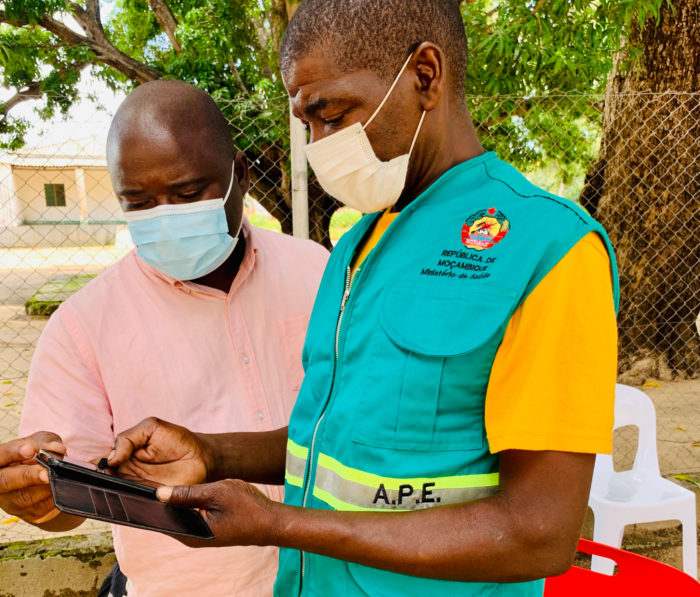Covid-19 has swept through the world like no other disease in the last century. Since its start, we’ve seen economies upended, health systems stretched beyond their limits, and millions of lives lost around the world. Pandemics like this were predicted by experts, and more like it are certain to arise in the future. It’s well worth the investment to explore how we can be best prepared for any future pandemics.
A year into this partnership, the three organizations—Dimagi, Medic, and The Rockefeller Foundation—have collaborated on a report to explore how investments in digital platforms for frontline workers (FLWs) today can help prepare for future pandemics. As of today, the report is available for download here, and we’ve outlined some of our key takeaways below.
Our Collaborative Covid-19 Response
Covid-19 has highlighted the role that digital technology, frontline workers, and rapid response strategies can play in lessening the toll of public health emergencies. Since early last year, The Rockefeller Foundation has been fostering a first-of-its-kind collaboration between Medic and Dimagi, two of the leaders of the field in mobile data collection tools for community health workers, to amplify the impact of their own and each other’s frontline technologies in response activities. It’s clear that no single solution or methodology will serve as a panacea for pandemic preparedness, but three core strategies can help:
- The development of early detection methods to help contain or avert outbreaks before they spread widely
- The readiness of rapid response tools that can be immediately deployed in the face of emergency
- The investment in general systems strengthening mechanisms to create immediate value and allow health systems to more effectively respond to emergencies, including advocating for the safety and preparedness for FLWs themselves in addition to the communities they serve
Even if a pandemic cannot be avoided, we can mobilize a more rapid response by detecting it earlier. And as we’ve seen from Covid-19, when it comes to emergency response, every day matters.
Through platforms such as CommCare and Community Health Toolkit, frontline workers routinely collect data on potential disease outbreaks as a part of their standard delivery. We can further leverage these data sets to identify possible outbreaks—either by further integrating them into national information systems or by running anomaly detection algorithms to identify potential new disease clusters. While the technology to enable this exists, organizations that use digital solutions need further incentives to participate in it.
Newly developed data sources could also be useful for pandemic detection, including platforms for viral threat such as Sentinel or improved digital RDT readers, such as Cloudworks. The goal is to better capture and utilize data for pandemic preparedness at the scale of the community, as well as invest in appropriate tools to effectively respond at the start of an emergency to blunt the impact as much as possible.
One key learning is that oftentimes, digital solutions are much more effective if they are in place before an emergency starts and can be rapidly adapted to blunt the impact of the pandemic for FLWs and the communities in which they live and work. Indeed, as Covid-19 reared its head and partners reached out for support, Dimagi and Medic were not starting from square-one. Rather, we were able to apply lessons learned from responding to Ebola in West Africa and routine surveillance from around the world.

Carrying Our Lessons Learned Forward
We will be carrying lessons learned from the past year into our future work, but there is still considerable room for investment to consolidate our work for Covid-19. If we can create a set of digital solutions to support a broad spectrum of communicable disease control efforts, we can enable a more rapid and more effective response next time.
One specific and immediate need is to support the rollout of solutions that can help to more equitably and effectively deliver Covid-19 vaccines. We anticipate the ongoing vaccination campaign will span years, and by investing in these solutions today, we believe we can begin to lay the groundwork for routine immunization solutions that can be quickly deployed whenever a new vaccine (or booster) is introduced.
Finally, investments in general health systems strengthening can positively impact pandemic preparedness. Namely, we discuss how investment in large-scale disease eradication tools can help serve as testbeds and training grounds for pandemic response – the idea being, the better equipped a health system is for case finding, treatment, supervision, etc. the better equipped it would be to do so for a novel emergency.
Further, we can extend our platforms or training methodologies such that new workflows can be added even more rapidly and easily integrated into programs. That way, when new workflows or new service delivery protocols need to be added to an application it can be added seamlessly and FLWs will know how to handle a new module on their screen.
The pandemic has also highlighted the importance of remote training and remote support for frontline workers. While the prior norm was lengthy, in-person meetings, Covid-19 demonstrated that in a situation where people cannot physically be together, the learning cannot stop. The report presents some of the potential ways in which digital technologies can improve training and establish the ability to do it with less or no in-person training.
To learn more about the work Dimagi, Medic, and The Rockefeller Foundation have been working on for the last year and more, please read our Pandemic Preparedness Report.
This report is based on work funded by The Rockefeller Foundation. The findings and conclusions contained within are those of the authors and do not necessarily reflect the positions or policies of The Rockefeller Foundation.
This article first appeared in Dimagi on July 20th, 2021, and is reposted with permission.
